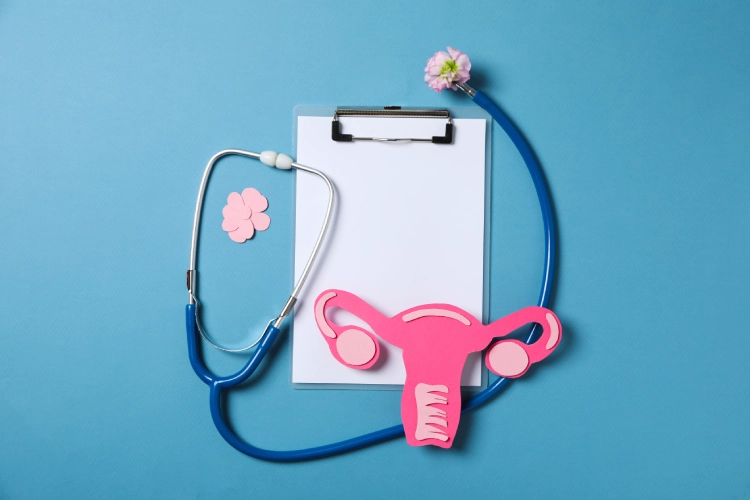



At Royal Hospital, our skilled gynecologists specialize in treating uterine fibroids with a range of advanced options, including minimally invasive surgical procedures like laparoscopic myomectomy. If you are experiencing symptoms related to uterine fibroids, schedule a consultation with our experienced team today to explore your treatment options and find relief.

Fibroids are a prevalent type of pelvic growth, affecting approximately 40-80% of individuals. They are benign growths found in the uterus, commonly emerging during pregnancy, and are also referred to as leiomyomas. Unlike cancerous growths, uterine fibroids do not elevate the risk of uterine cancer and seldom develop into cancerous formations. These fibroids vary in size, ranging from minuscule seedlings undetectable to the naked eye to substantial masses capable of distorting or enlarging the uterus. They can manifest as solitary or multiple growths, with severe cases involving multiple fibroids causing significant uterine enlargement, even extending to the rib cage.
The precise cause of uterine fibroids remains elusive. Typically, these growths manifest in women of reproductive age, a demographic characterized by elevated levels of oestrogen and progesterone. However, fibroids can also emerge during and after menopause. Heightened oestrogen levels predispose fibroids to swelling, particularly during pregnancy, whereas reduced oestrogen levels are associated with fibroid contraction. Fibroids exhibit diverse growth patterns, with some expanding slowly over time, others undergoing rapid growth, and certain ones maintaining a consistent size. While some fibroids may shrink spontaneously, many vanish as the uterus returns to its normal size post-pregnancy.
Symptoms of fibroids can vary greatly among women, as each individual's experience is unique. Larger fibroids, however, may present with the following manifestations:
There are four primary types of fibroids, each with distinct characteristics:
These fibroids originate within the muscular wall of the uterus. They have the potential to enlarge and expand the uterus due to their location. Intramural fibroids can develop within the body's cavities.
These fibroids can grow to a size where they cause one side of the uterus to appear enlarged.
Pedunculated fibroids occur when a subserosal fibroid develops a stalk or stem. This stem forms a thin base that supports the tumour, resulting in pedunculated growth.
These fibroids develop in the myometrium or the middle muscular layer of the uterus. Compared to the other three types, submucosal fibroids are less common.
When fibroids are suspected, a thorough diagnostic process is initiated by Doctors. This typically begins with a pelvic examination to identify any visible signs. During this examination, the number, size, and potential growth of fibroids are assessed, providing valuable insights into treatment options. Additionally, several tests may be conducted to gather more information about the fibroids:
This is often the initial diagnostic test ordered to confirm the presence of fibroids. Ultrasound utilizes sound waves to generate images of the uterus, allowing doctors to visualize, locate, and measure fibroid size. The ultrasound can be performed externally using a device placed on the abdomen or internally through a transvaginal approach.
In conjunction with imaging tests, blood tests may be recommended to determine Abnormal menstrual bleeding associated with fibroids can lead to conditions such as anaemia, bleeding disorders, or thyroid abnormalities, which can be detected through blood tests.
Treatment options for fibroids vary based on factors such as the fibroids' characteristics, size, location, and the patient's age and overall health. Doctors offer a range of treatment options tailored to individual needs:
Medications are prescribed to address symptoms like heavy menstrual bleeding and pelvic discomfort caused by fibroids. Hormonal medications can help regulate menstrual cycles and reduce bleeding. Gonadotropin- releasing hormone (GnRH) agonists may be prescribed to temporarily halt menstrual cycles and shrink fibroids. Progestin-releasing intrauterine devices (IUDs) are also used to alleviate excessive bleeding.
Various minimally invasive surgical techniques can remove or reduce fibroids:
Uterine artery embolization involves blocking blood flow to fibroids by injecting embolic agents into uterine arteries.
Radiofrequency ablation employs radiofrequency energy to destroy fibroids by constricting blood vessels.
Laparoscopic or robotic myomectomy removes fibroids through small abdominal incisions.
Hysteroscopic myomectomy is used for submucosal fibroids, involving the removal of fibroids through instruments inserted via the vagina and cervix.
When large, recurrent fibroids persist despite other treatments, surgical options such as abdominal myomectomy and hysterectomy may be considered:
Abdominal myomectomy involves removing fibroids through an abdominal incision.
Hysterectomy is the complete removal of the uterus and is a permanent solution for fibroids. It should be discussed thoroughly with the doctor before undergoing the procedure.
Doctors carefully assess each patient's condition to recommend the most suitable treatment approach, ensuring optimal outcomes and patient satisfaction.
During the consultation, Doctors will provide detailed information about the potential risks associated with uterine fibroid treatment. These risks may include recurrence, infection and bleeding, which are common to any surgical procedure.

